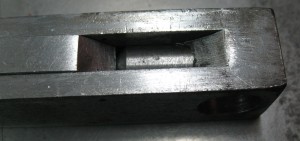One part of my Challenge MA15 proof press that I cannot figure out is the lockup bar, used as a quick way of clamping the type in position on the bed.

The parts of the lockup bar. Note that the main body is reversed relative to the other parts, so the eccentric near upper right actually fits into the left-hand end of the body. The insert bar goes in bevels up and two small roll pins (top center) retain it loosely.
The bar has a locking lever which turns an eccentric which in turn pushes on a plunger. This in turn pushes a long bar set into the side of the lockup bar, which pushes a plunger at the other end of the bar. As this last plunger is pushed out the end of the bar, the bar becomes clamped between the rails of the press, locking it in place. An adjusting screw is used to vary the effective length of this last plunger so the clamping takes place within the limited range of the eccentric.
It seems to me that the long bar should also push out of the side of the lockup bar to further tighten up the type, but I don’t see how that can happen. The beveled ends of the side bar are positioned to allow the retaining roll pins to do their job so there is no wedge action trying to push the side bar out. Although one of the plungers has a tapered end, the flat end of the taper is too large, and the other plunger has no taper at all. For this to work the way I expect, both plungers would need tapered ends and/or the side bar would need bevels on its back as well as its front.
The parts diagram for the press does not include this lockup bar. The only thing I can tell that is obviously wrong is that the locking handle has some extra bends that should not be there…
Any ideas on how this is supposed to work would be appreciated!



…And I answer my own question. I was about to post the same conundrum on the Vanderblog site when I thought I should try a quick web search first. Sure enough, another part of the vandercookpress.info site had a list of Challenge’s patents including a link to US patent number 3288062 which shows the parts and explains the operation of this lockup bar.
The side bar does not push out. Instead it bows out because of the compression applied only to its rear face.
So it would seem that all I have to do is straighten the extra bends in the lever and assemble everything with appropriate lubrication. Careful setting of the length adjustment screw is critical to proper operation of this bar.